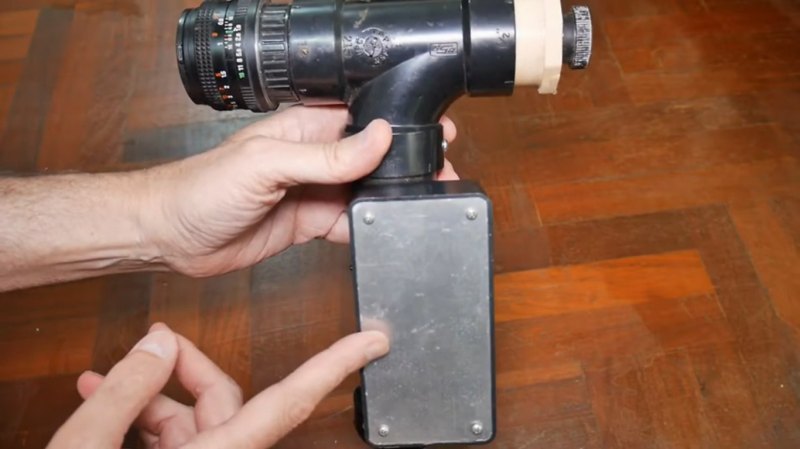Old military equipment can sometimes be found in places like flea markets and eBay for pennies, often because people don’t always know what they have. While [tsbrownie] knew exactly what he was getting when he ordered this mystery device, we’re not sure we could say the same thing if we stumbled upon it ourselves. What looks like a vacuum tube of some sort turns out to be an infrared sensor from an old submarine periscope that was repurposed as a night vision device. (Video, embedded below.)
Of course, getting a tube like this to work requires high voltage. This one specifically needs 3500V in order to work properly, but this was taken care of with a small circuit housed in a PVC-like enclosure. The enclosure houses the tube in the center, with an eye piece at one end and a camera lens at the other, attached presumably by a 3D-printed mount. The electronics are housed in the “grip” and the whole thing looks like a small sightglass with a handle. Once powered up, the device is able to show a classic green night vision scene.
Old analog equipment like this is pretty rare, as are people with the expertise to find these devices and get them working again in some capacity. This is a great video for anyone with an interest in tubes, old military gear, or even if you already built a more modern night vision system a while back.
Thanks to [Zzp100] for the tip!
















Thats an old philips tube. Not that great, it’s a generation 1 device. The US used something similar to this in a cascaded configuration where the output of one was waterfalled into another, three times. It’s called the PVS-1.
I think this is not an IR sensor. IR does not cross glass . When [tsbrownie] looks the windows they are transparent. If the sensor had worked in the infrared, the windows would have looked completely black.
To me, it is an image intensifier. It does not work in the IR part of the spectrum but in the visible part of it. It multiplies photon by accelerating them and projecting them on a phosphor target.
Most image intensifiers work in the near IR spectrum, which does pass through glass. You are thinking about far IR which does not.
They usually have quite a broad spectral response from near IR to blue. An illuminator, if used, is almost always in the near IR band for obvious reasons.
Some image intensifiers are used with a pyroelectric device to work as a LWIR thermal imager. The performance of this is poor compared to modern thermal sensors, but you do get an image with recognizable detail.
Tell that to people in desert climates. Were you by chance on the first generation Austin Mini (re)design team? ‘Our glass roof work wells for our UK design mule. Bring it to Arizona!’
I doubt it is infra red, because infra red needs germanium lenses ?
So his “normal camera” lens blocks the infra red spectrum.
Infrared covers a huge range, glass is good up to about 2000nm, well into infrared. You are thinking thermal IR which cameras cover MWIR (3-5000nm) and LWIR (9-14knm) Those require germanium, gallium arsenide, or plastic optics.
Do the optical systems use the salt lenses also like laboratory systems? Kind of like scintillation tubes needing to be sealed or in a desiccant environment.
And a hollowed out 3rd party rear lens cap for the 50mm mount. I can’t quite figure out the lens mount, Minolta maybe?
Classic project from 80’s Popular Electronics back when you could barely imagine touching a night vision scope.
Also, ugh, scoff, scoff, DIY night vision scope already covered on hackaday before. Just go to the article from 2005 and then the green-on-black Angelfire website with 360×240 pixel images, duh /s
https://hackaday.com/2005/01/26/homemade-night-vision-scope/
The intensifier looks like it has an input lens. Maybe a selenium lens? It has a funny tint. If, the camera lens will be robing it of a lot of IR. Intensifiers I have used run at between 800 and 1800 volts. Maybe there are two cascaded? Or he misremembers the voltage produced by his circuit? Very cool either way. I wonder if these can be found cheap.
That’s the photocathode. A very thin layer of metal on the glass. It is charged to a high voltage and when light hits it electron are knocked off and accelerated and focused on the rear phosphor screen. This is an old Gen 1 tube which suck big time compared to the new Gen3 tubes which use micro channel plates.
Basic diagram of the tube in this article.
https://www.photonics.com/Articles/Image_Intensification_The_Technology_of_Night/a25144
Oh, and yes, old tubes ran at very high voltages compared to modern tubes.
Nice use of plumbing fittings!
Pretty sure this is actually a 6099 tube which needs about 10kv more than he is pumping through it. It will work at lower voltages, just not as bright output.